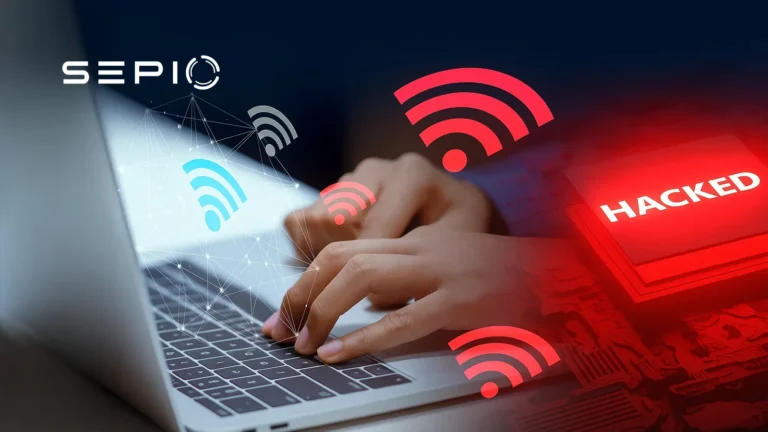Today, Wi-Fi is ubiquitous—we encounter it in homes, offices, coffee shops, airports, hospitals, and even on the street. This widespread use of Wi-Fi underscores the increasing WiFi risks that individuals and organizations need to be aware of.
The internet has become integral to our personal and professional lives, and its role in society continues to grow. According to the Cisco Annual Internet Report (2018-2023), two-thirds of the global population will have internet access by 2023, up from just over half in 2019. While this progress brings numerous benefits, it also exposes users to greater Wi-Fi vulnerabilities, making it an attractive target for cybercriminals.
Rogue Access Points
A rogue access point (AP) can be classified as any access point that is not authorized to be operating on the network. Some rogue APs are benign in nature, only set up to provide greater coverage or access to blocked websites. While these access points do present a serious security risk to the user and network administrator, the most threatening rogue access points are those created by bad actors with malicious intent.
Known as an Evil Twin, the rogue access points impersonates a legitimate access points by spoofing its SSID to trick users into connecting to it. Evil Twins have allowed cybercriminals to adapt to the dynamic cybersecurity defenses deployed to block cyber-attacks by exploiting the “blind spots”.
Organizations lack the ability to identify unauthorized BSSIDs. So, when a rogue access points is present there is no indication of this. Users are therefore at risk of connecting to the Evil Twin, completely unaware of its malicious nature. The attacker can remotely carry out attacks once users have connected to the rogue access points and, essentially, steal data out of thin air.
Understanding WiFi Risks
The rogue access point (AP) attempts to disrupt the connection between a user and a legitimate AP by sending deauthentication packets. For users not yet connected, this step is unnecessary. Once a user is within range, the rogue AP broadcasts a stronger signal than the legitimate AP to force the user to connect to it. Since the rogue AP shares the same SSID as the legitimate AP, the user is unaware of any malicious activity. Once connected to the Evil Twin, users are at risk of man-in-the-middle (MiTM) attacks, packet sniffing, data breaches, and other cybersecurity threats.
The rogue AP acts as the middleman between the user and the services they access. This allows the attacker to intercept and manipulate data transmissions. The perpetrator can steal sensitive information such as financial data, credentials, and network activity. Advanced Evil Twin attacks can also give attackers access to additional systems, escalating the potential for further damage. These WIFI risks highlight the critical importance of securing wireless networks.
Evil Twin attacks are not a new threat and can be used for sophisticated reconnaissance. In 2018, the US Department of Justice (DoJ) charged Russian hackers with conducting Evil Twin attacks against various organizations, including anti-doping agencies. The attackers used these attacks to steal data and potentially hijack networks—all from the safety of a nearby vehicle.
Internet of Things (IoT), Remote Work & Employee Negligence: Key WiFi Risks
Internet of Things (IoT) – Expanding the Attack Surface
With 35 billion IoT devices in use today and an expected surge to 83 billion by 2024 (Juniper Research), the risk of Evil Twin attacks is greater than ever. These attacks exploit WIFI vulnerabilities, creating billions of opportunities for cybercriminals.
Beyond digital security concerns, IoT devices now play a critical role in infrastructure operations, where cyber threats can cause physical damage. A prime example is the healthcare industry, which relies on the Internet of Medical Things (IoMT) for patient care. The IoMT market is growing by nearly 30% annually, and compromised devices could lead to life-threatening consequences if they accidentally connect to a rogue access point (AP).
Remote Work – A Gateway for Attackers
The COVID-19 pandemic reshaped work culture, making remote work a permanent fixture for many businesses. A Gartner study revealed that 82% of organizations now allow employees to work from home at least one day a week. While this offers flexibility, it also increases WIFI risks, especially from Evil Twin attacks.
Public locations like coffee shops and libraries are hotspots for remote workers—and for cybercriminals. Attackers set up rogue APs with deceptive names like “StarbucksFreeWiFi,” tricking users into connecting to a malicious network. Since users naturally opt for the strongest signal, they unknowingly expose their data to hackers.
Even home networks are not immune. Many employees assume their home WIFI is secure, but Evil Twin attacks can compromise both personal and corporate information. With sensitive company data often stored on personal devices, the risk remains constant.
Employee Negligence – The Human Factor in WiFi Security
Employees are an organization’s biggest security vulnerability, largely due to insider privileges and human error. A Proofpoint study found that human error is the primary cybersecurity risk for over half of organizations. When it comes to WIFI risks, businesses rely on employees to avoid connecting to rogue APs—but this is easier said than done.
Evil Twin attacks are highly deceptive, and most users don’t verify AP legitimacy before connecting. Cybersecurity awareness remains low, making employees more likely to fall victim to rogue networks. The danger extends beyond work hours, as devices often retain access to confidential company data. A single misstep—whether at a café, hotel, or home—can put an entire organization at risk.
Eliminating WiFi Risks with Rogue AP Detection
Sepio’s Asset Risk Management solution provides unmatched visibility and protection against rogue access points (APs), closing security gaps that traditional tools miss. When a rogue AP is detected, Sepio automatically triggers mitigation, integrating seamlessly with your security stack to prevent Evil Twin attacks and other WIFI risks.
Beyond Wi-Fi security, Sepio delivers comprehensive asset visibility across IT, OT, and IoT environments. As the leader in Rogue Device Mitigation (RDM), it enforces Zero Trust Hardware Access, instantly blocking unauthorized or rogue devices to safeguard critical infrastructure.
Fast & Seamless Deployment – No extra hardware, no traffic monitoring, and full visibility in 24 hours without impacting user experience. Schedule a Demo to see Sepio in action.
Read the paper Mitigating Wi-Fi Risks (pdf)





